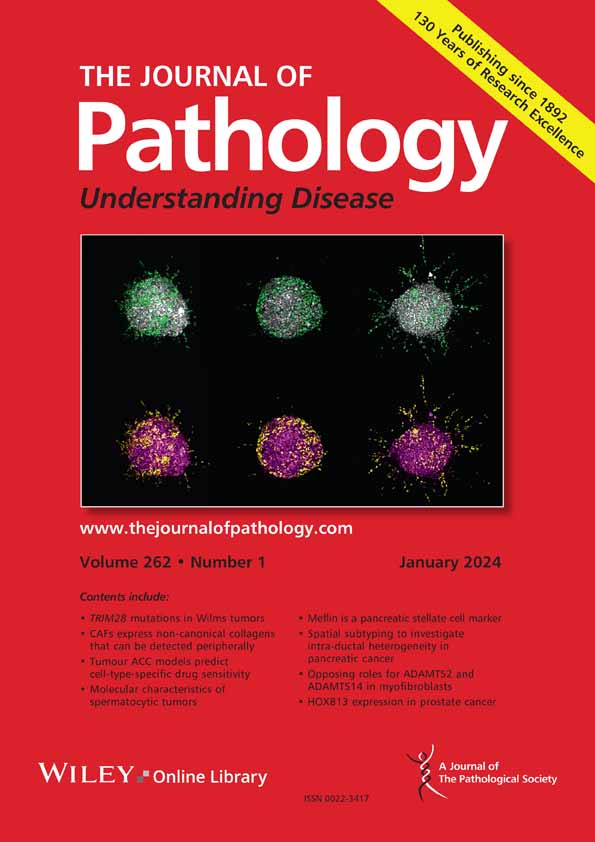Yang Qu, Xiaoli Feng, Hanlin Chen, Fengwei Tan, Anqi Shao, Jiaohui Pang, Qi Xue, Bo Zheng, Wei Zheng, Qiuxiang Ou, Shugeng Gao, Kang Shao
求助PDF
{"title":"Multi-omics analyses reveal distinct molecular characteristics and transformation mechanisms of stage I–III micropapillary lung adenocarcinoma","authors":"Yang Qu, Xiaoli Feng, Hanlin Chen, Fengwei Tan, Anqi Shao, Jiaohui Pang, Qi Xue, Bo Zheng, Wei Zheng, Qiuxiang Ou, Shugeng Gao, Kang Shao","doi":"10.1002/path.6416","DOIUrl":null,"url":null,"abstract":"<p>The micropapillary (MIP) pattern is a high-grade histological subtype of lung adenocarcinoma (LUAD) with poor prognosis. In this study, surgically resected tumor samples from 101 patients with stage I–III MIP–LUAD (MIP ≥30%) were microdissected to separate MIP components from non-MIP components, all of which underwent RNA and DNA whole-exome sequencing (WES). The genomic and transcriptomic landscapes of MIP and non-MIP components within MIP-enriched tumor tissues demonstrated remarkable similarities, notably marked by high epidermal growth factor receptor (EGFR) alteration frequencies. However, when compared to MIP-naïve LUAD tissues, MIP components showed higher chromosomal instability and revealed 18 enriched alterations, encompassing EGFR mutations, EGFR amplifications, and CDKN2A/CDKN2B deletions, which all linked to upregulation of cell proliferation pathways and downregulation of immune pathways. Shared mutations were observed in 97.8% (91/93) of patients with paired DNA WES data for MIP and non-MIP components within the same tissues, suggesting a common origin. The recurrence-free survival analysis identified MACF1, PCLO, ADGRV1, and Fanconi Anemia pathway mutations as negative indicators. In all, we conducted an in-depth analysis of the molecular characteristics and transformation mechanisms of MIP–LUAD, employing microdissection techniques to investigate the genomic and transcriptomic levels within a substantial cohort, providing insights for precision medicine of this aggressive cancer subtype. © 2025 The Pathological Society of Great Britain and Ireland.</p>","PeriodicalId":232,"journal":{"name":"The Journal of Pathology","volume":"266 2","pages":"204-216"},"PeriodicalIF":5.2000,"publicationDate":"2025-03-28","publicationTypes":"Journal Article","fieldsOfStudy":null,"isOpenAccess":false,"openAccessPdf":"","citationCount":"0","resultStr":null,"platform":"Semanticscholar","paperid":null,"PeriodicalName":"The Journal of Pathology","FirstCategoryId":"3","ListUrlMain":"https://pathsocjournals.onlinelibrary.wiley.com/doi/10.1002/path.6416","RegionNum":2,"RegionCategory":"医学","ArticlePicture":[],"TitleCN":null,"AbstractTextCN":null,"PMCID":null,"EPubDate":"","PubModel":"","JCR":"Q1","JCRName":"ONCOLOGY","Score":null,"Total":0}
引用次数: 0
引用
批量引用
Abstract
The micropapillary (MIP) pattern is a high-grade histological subtype of lung adenocarcinoma (LUAD) with poor prognosis. In this study, surgically resected tumor samples from 101 patients with stage I–III MIP–LUAD (MIP ≥30%) were microdissected to separate MIP components from non-MIP components, all of which underwent RNA and DNA whole-exome sequencing (WES). The genomic and transcriptomic landscapes of MIP and non-MIP components within MIP-enriched tumor tissues demonstrated remarkable similarities, notably marked by high epidermal growth factor receptor (EGFR) alteration frequencies. However, when compared to MIP-naïve LUAD tissues, MIP components showed higher chromosomal instability and revealed 18 enriched alterations, encompassing EGFR mutations, EGFR amplifications, and CDKN2A/CDKN2B deletions, which all linked to upregulation of cell proliferation pathways and downregulation of immune pathways. Shared mutations were observed in 97.8% (91/93) of patients with paired DNA WES data for MIP and non-MIP components within the same tissues, suggesting a common origin. The recurrence-free survival analysis identified MACF1, PCLO, ADGRV1, and Fanconi Anemia pathway mutations as negative indicators. In all, we conducted an in-depth analysis of the molecular characteristics and transformation mechanisms of MIP–LUAD, employing microdissection techniques to investigate the genomic and transcriptomic levels within a substantial cohort, providing insights for precision medicine of this aggressive cancer subtype. © 2025 The Pathological Society of Great Britain and Ireland.
多组学分析揭示了I-III期肺微乳头状腺癌的独特分子特征和转化机制。
微乳头状(MIP)模式是肺腺癌(LUAD)的高级别组织学亚型,预后较差。本研究对101例I-III期MIP- luad (MIP≥30%)手术切除的肿瘤样本进行显微解剖,将MIP成分与非MIP成分分离,并对所有MIP成分进行RNA和DNA全外显子组测序(WES)。在MIP富集的肿瘤组织中,MIP和非MIP成分的基因组和转录组学景观显示出显著的相似性,特别是表皮生长因子受体(EGFR)的高改变频率。然而,与MIP-naïve LUAD组织相比,MIP组分表现出更高的染色体不稳定性,并显示出18个富集的改变,包括EGFR突变、EGFR扩增和CDKN2A/CDKN2B缺失,这些都与细胞增殖途径的上调和免疫途径的下调有关。97.8%(91/93)具有相同组织中MIP和非MIP成分配对DNA WES数据的患者中发现了共享突变,这表明它们具有共同的起源。无复发生存分析发现MACF1、PCLO、ADGRV1和Fanconi贫血途径突变为阴性指标。总之,我们对MIP-LUAD的分子特征和转化机制进行了深入分析,采用显微解剖技术研究了大量队列中的基因组和转录组水平,为这种侵袭性癌症亚型的精准医学提供了见解。©2025英国和爱尔兰病理学会。
本文章由计算机程序翻译,如有差异,请以英文原文为准。






 求助内容:
求助内容: 应助结果提醒方式:
应助结果提醒方式:


